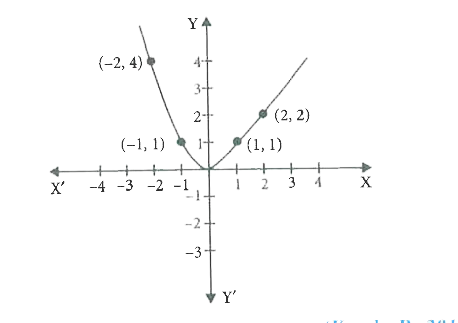Complete Solutions to Objective Type Questions (D. Very Short Answer Types Questions) of chapter RELATIONS AND FUNCTIONS of Class 12 book with complete answers and questions
| Class 12 | MATHS |
| Chapter | RELATIONS AND FUNCTIONS |
| MODERN PUBLICATION | Objective Type Questions (D. Very Short Answer Types Questions) |
| Number Of Questions | 29 |
| Academic Year | 2023-24 |
Let `A={1,2,3,4}`. Let R be the equivalence relation on `AxxA` defined by `(a,b)R(c,d)` iff `a+d=b+c`. Find `{(1,3)}`.
06:17View SolutionIf `R={(1,-1),(2,-2),(3,-1)}` is a relation, then find the range of R.
02:28View SolutionIf `R={(x,y):x+2y=10}` is a relation in N, write the range of R.
01:37View SolutionGive an example of a relation which is reflexive and symmetric but not transitive.
04:02View SolutionGive an example of a relation which is transitive but neither reflexive nor symmetric.
01:59View SolutionLet R be the relation ''greater than'' from `A={1,4,5}` to `B={1,2,4,5,6,7}`. Write down the elements corresponding to R.
03:45View SolutionWhich one of the following graphs represents the function of x? why?
 03:08View Solution
03:08View SolutionShow that `f(x)=3x+5` for all `xinQ`, is one-one.
01:12View SolutionShow that the function `f: N->N` , given by `f(x)=2x` , is one-one but not onto.
02:24View SolutionIf f is a function from `RrarrR` such that `f(x)=x^(2)AA x inR`, then show that 'f' is not one-one.
02:40View SolutionLet `A = {1, 2, 3}`, `B = {4, 5, 6, 7}`and let `f = {(1, 4), (2, 5), (3, 6)}`be a function from A to B. Show that f is one-one.
02:08View SolutionThe function P is defined as:
''To each person on the earth is assigned a date of birth''. Is this function one-one? Give reason.02:50View SolutionWrite the function whose graph is shown below:
 02:17View Solution
02:17View SolutionConsider functions f and g such that composite gof is defined and is one-one. Are f and g both necessarily one-one.
03:55View SolutionAre f and g both necessarily onto, if `gof`is onto?
03:40View SolutionGive examples of two functions `f:" "N->Z" "a n dg:" "Z->Z` such that o f is injective but is not injective. (Hint: Consider `f(x)" "=" "x" "a n d""""""""g(x)" "=" "|x|` )
05:03View SolutionGive examples of function:
`f:NrarrN and g:NrarrN`
such that gof is onto but f is not onto.04:56View SolutionFind fog, if `f:RrarrR` and `g:RrarrR` are given by:
`f(x)=cosxandg(x)=x^(2)`.00:54View SolutionIf f (x) = sin x, g(x) = `x^(2)`, if `x inR`, then find [(fog)(x)].
00:49View SolutionIf `f:RrarrR` is defined by `f(x)=3x+1`, find `f(f(x))`.
00:58View SolutionLet `'**'` be a binary operation on N given by:
`a**b=LCM (a,b)` for all `a, b inN`.
Find `6**7`01:14View SolutionLet `'**'` be a binary operation on N given by:
`a**b=LCM (a,b)` for all `a, b inN`.
Find `20**16`01:37View SolutionThe binary operation `**:RxxRrarrR` is defined as:
`a**b=2a+b`.
Find `(2**3)**5`.00:54View SolutionShow that `+ : R xx R ->R`and `xx : R xx R ->R`are commutative binary operations, but ` : RxxR ->R`and `-: : R_* xxR_* ->R_*`are not commutative.
02:38View SolutionShow that `+ : R xx R ->R`and `xx : R xx R ->R`are commutative binary operations, but ` : RxxR ->R`and `-: : R_* xxR_* ->R_*`are not commutative.
02:38View SolutionShow that addition and multiplication are associative binary operation on R. But subtraction is not associative on R. Division is not associative on R*.
04:46View SolutionShow that subtraction and division are not binary operations on N.
02:31View SolutionShow that `" "a` is not the inverse of `a in N` for the addition operation + on N and `1/a` is not the inverse of `a in N` for multiplication operation `xx` on N, for `a!=1` .
04:30View SolutionShow that `" "a` is not the inverse of `a in N` for the addition operation + on N and `1/a` is not the inverse of `a in N` for multiplication operation `xx` on N, for `a!=1` .
04:30View Solution
Objective Type Questions (D. Very Short Answer Types Questions) questions and complete solutions for chapter RELATIONS AND FUNCTIONS of ARIHANT MATHS (HINGLISH) of Class 12
All Exercises from MODERN PUBLICATION Class 12 MATHS RELATIONS AND FUNCTIONS
- CHAPTER TEST (1)
- CHECK YOUR UNDERSTANDING
- COMPETITION FILE (Questions from JEE Main)
- Exercise
- EXERCISE 1 (a) (Long Answer Type Questions (I))
- EXERCISE 1 (a) (Long Answer Type Questions (II))
- EXERCISE 1 (a) (Short Answer Type Questions)
- EXERCISE 1 (b) (Long Answer Type Questions (I))
- EXERCISE 1 (c) (Long Answer Type Questions (I))
- EXERCISE 1 (c) (Short Answer Type Questions)
- EXERCISE 1 (d) (Long Answer Type Questions (I))
- EXERCISE 1 (d) (Short Answer Type Questions)
- EXERCISE 1 (e) (Long Answer Type Questions (I))
- EXERCISE 1 (e) (Short Answer Type Questions)
- FREQUENTLY ASKED QUESTIONS
- ILLUSTRATIVE EXAMPLES
- Misellaneous Exercise on Chapter (1)
- NCERT - FILE (Question from NCERT Book) (Exercise 1.1)
- NCERT - FILE (Question from NCERT Book) (Exercise 1.2)
- NCERT - FILE (Question from NCERT Book) (Exercise 1.3)
- NCERT - FILE (Question from NCERT Book) (Exercise 1.4)
- Objective Type Questions (A. Multiple Choice Questions)
- Objective Type Questions (B. Fill in the Blanks)
- Objective Type Questions (C. True/False Questions)
- Objective Type Questions (D. Very Short Answer Types Questions)
- QUESTIONS FROM NCERT EXEMPLAR
- Revision Exercise
